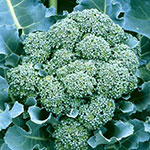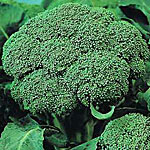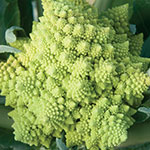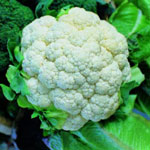Hello gardeners! We hope your winter planning season went well. (you have been planning your spring garden, haven’t you?) More now than ever, it is important for you to be food independent, and as a result we’ll have a bumper supply of seedlings available. Please call for availability though as weather during the next few weeks may affect the supply. IMPORTANT NOTICE! Every Saturday, starting April 31, 10am-2pm, I will be set up at Roscoes, 94 Green River Rd, Zirconia. Click HERE for a map.
All seedlings below will be available for $2.00/4-pack. 12 4-packs per flat (48 plants): $20.00

Broccoli
Broccoli is a plant in the cabbage family, whose large flower head is used as a vegetable. The word broccoli, from the Italian plural of broccolo, refers to “the flowering top of a cabbage”. Broccoli is usually boiled or steamed, but may be eaten raw and has become popular as a raw vegetable in hors d’œuvre trays.
Broccoli evolved from a wild cabbage plant on the continent of Europe. Indications point to the vegetable’s being known 2,000 years ago. Since the Roman Empire, broccoli has been considered a uniquely valuable food among Italians. Broccoli was first introduced to the United States by Italian immigrants but did not become widely known until the 1920s.
Broccoli is high in vitamin C, as well as dietary fiber; it also contains multiple nutrients with potent anti-cancer properties, such as diindolylmethane and small amounts of selenium. A single serving provides more than 30 mg of Vitamin C and a half-cup provides 52 mg of Vitamin C. The 3,3′-Diindolylmethane found in broccoli is a potent modulator of the innate immune response system with anti-viral, anti-bacterial and anti-cancer activity. Broccoli also contains the compound glucoraphanin, which can be processed into an anti-cancer compound sulforaphane, though the benefits of broccoli are greatly reduced if the vegetable is boiled. Broccoli is also an excellent source of indole-3-carbinol, a chemical which boosts DNA repair in cells and appears to block the growth of cancer cells. Broccoli prefers cool temperatures and a regular supply of water. In many regions it can be grown as both a spring and fall crop.
NEW! Green Magic F1
Heads are smooth, well domed, and very attractive. Extremely uniform in maturity. Similar to Gypsy, but with a smaller plant, smoother heads, and better uniformity. For summer harvest. Broccoli prefers a well-drained, fertile soil high in organic matter, a pH of 6.0-7.5 with a consistent supply of moisture throughout the growing season. Irrigate regularly for best results. While more heat-tolerant varieties are now on the market, Broccoli does not generally do well in hot weather. The best success is with spring and fall crops. Days to maturity: 57
Arcadia
 Arcadia is a Broccoli variety in the Mustard genus with a scientific name of Brassica oleracea (Italica Group). Arcadia is a hybrid variety. This variety is an Vegetable that typically grows as an Annual, which is defined as a plant that matures and completes its lifecycle over the course of a single year. Arcadia is known for growing to a height of approximately 75.0 cm (2.44 feet).
Arcadia is a Broccoli variety in the Mustard genus with a scientific name of Brassica oleracea (Italica Group). Arcadia is a hybrid variety. This variety is an Vegetable that typically grows as an Annual, which is defined as a plant that matures and completes its lifecycle over the course of a single year. Arcadia is known for growing to a height of approximately 75.0 cm (2.44 feet).
Arcadia Broccoli needs a moderate amount of maintenance, so some level of previous experience comes in handy when growing this plant. Ensure that you are aware of the soil, sun, ph and water requirements for this plant and keep an eye out for pests. Try to plant in a location that enjoys partial sun and remember to water moderately. Keep in mind when planting that Arcadia is thought of as tender, so it is really important to plant out well after your last frost date. Days to maturity: 63
Cauliflower
Cauliflower is one of several vegetables in the species Brassica oleracea, in the family Brassicaceae. It is an annual plant that reproduces by seed. Typically, only the head (the white curd) eaten. The cauliflower head is composed of a white inflorescence meristem. Cauliflower heads resemble those in broccoli, which differs in having flower buds.
Its name is from Latin caulis (cabbage) and flower. Brassica oleracea also includes cabbage, brussels sprouts, kale, broccoli, and collard greens, though they are of different cultivar groups.
Romanesco

Romanesco broccoli, also known as Roman cauliflower, Broccolo Romanesco, Romanesque cauliflower or simply Romanesco, is an edible flower bud of the species Brassica oleracea. First documented in Italy, it is chartreuse in color. Romanesco has a striking appearance because its form is a natural approximation of a fractal. When compared to a traditional cauliflower, its texture as a vegetable is far more crunchy,[according to whom?] and its flavor is not as assertive, being delicate and nutty.
Plant in full sun, 24″ apart. Days to maturity: 78
Early Snowball
Introduced to American gardeners in 1888 by Peter Henderson & Company. Smooth 6-7″ heads of tightly formed white curds are solid, crisp, and tender, excellent quality. Can be over-wintered for early crops in warmer regions. Cauliflower prefers cool temperatures and a regular supply of water.
Plant in full sun, 24″ apart. Days to maturity: 52
Days to maturity are from transplanting
